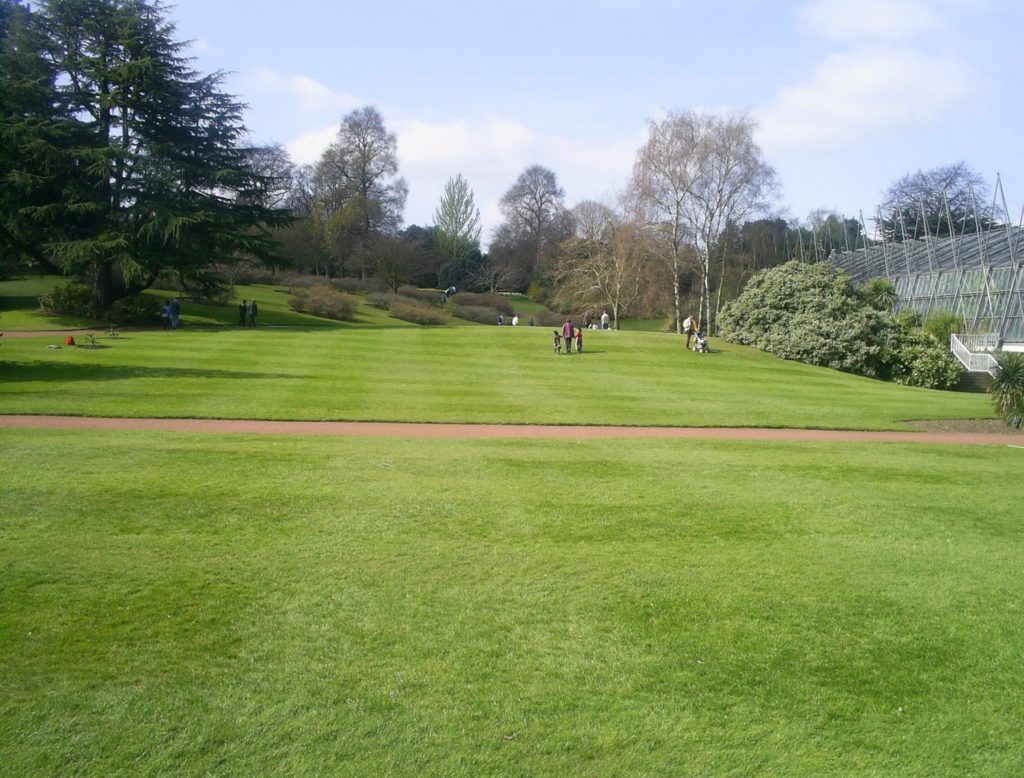The regularly mown lawn is a worthy garden feature with borders chock full of plants and hedges in a garden a wildlife retreat is formed. A landing strip for the larger birds within a leaf rich canopy the perimeter is suited to the song bird population. The regularly mown lawn is going against all current views that promote wild flower meadows, rain gardens, and living landscapes all with a less frequent cutting regime than the traditional garden lawn. Gradually public perception of open spaces with longer grass due to lengthened mowing frequencies is gaining acceptance. However my view is that mowing a lawn regularly and frequently will result in a habitat conducive to wildlife.
Referring to the RHS Dictionary of Horticulture there is a history of lawns since Pliny the Younger (61-113AD). I would take this back a further two thousand years to the time when stone circles were constructed and the area within, as tramped grassland, resembled the early predecessor to a closely mown lawn. In Edinburgh, what better pedigree could a city have to evoke thoughts of lawns than the Lawnmarket and Grassmarket?
In a lawn there are three layers to consider; the living green canopy of grass foliage, the thatch layer of dead, decaying plant material and below these two and supporting them the soil profile. Delve through the living green sward into the thatch below and this is where the action takes place. Constantly moist even through a hot, dry spell in the summer.
Reducing the aeration and scarification operations as these operations are designed to reduce, if not eliminate the thatch layer. This layer of dead, decaying vegetation holds the key to the coexistence of a myriad range of worms, beetles, solitary bees, larvae, slugs, spiders, flies and mites. There is a constant moisture source deep within the thatch layer well suited to promoting and preserving life. Insects feed on this material and birds scratch out moss for nesting material; this is an invaluable habitat.
One disadvantage to promoting the lawn as a biodiverse habitat is the narrow monoculture of grass species. The lawn is a dynamic environment and over time the sward does become colonised by varied species of grass and broadleaved plants. Strengths and weaknesses of plant association coupled with our changeable climate and mowing regime make change inevitable within the plant community composing a garden lawn. As the species proliferate within the lawn so the vegetation layer is enriched and a wider range of species, both plant life and fauna observed.
Grass clippings provide a source of food for the garden’s bird population. On mowing, tip the contents of the grass box out as a heap onto an area of bare soil. The birds will soon forage through, levelling the slowly decomposing clippings in their quest for grubs. Micro-organisms will convert raw decaying plant material adding organic matter to the soil, converting to humus which binds soil particles, aids fertility and improves soil structure. This rejuvenates soil and increases the amount of organisms present. Worm activity also increases leading to improved drainage and aeration. Alternatively, allow the clippings to drop back to the lawn. These brown, shrivel and reduce down bulking up the existing thatch layer adding springiness to the footstep. When mowing set the mower at a cutting height that will not remove more than one third of the green leaf. Never set the blades low to scalp the lawn in the mistaken thought that by doing so will save you time before the need to make a subsequent cut. As well as a visual disaster this destroys the top habitat layer and eats into the mid layer, disturbing the thatch. There is more to mowing than walking behind the machine.
The mown lawn also provides a restful, tranquil area for activities and to relax. The one discord is the use of a petrol or diesel mower to manage the height of cut. These use carbon resources. A lower carbon alternative of electricity and battery powered machinery is now available. Where feasible these should be chosen; reducing the carbon footprint. Long term, lawns sequester carbon capturing atmospheric Co2 and storing it beneath the root zone.
Lawns act to provide a cooling surface within cities that heat up with the amount of hard and reflective surfaces causing heat islands. In cities, generations of office workers are thankful of these green spaces as a restful space to spend the lunch break topping up on vitamin D.
The to and fro of the mower, the creation of formality with parallel dark and light stripes are a timeless feature in a garden. Appreciate the attention to detail and the skill of the gardener and hold these dear.

